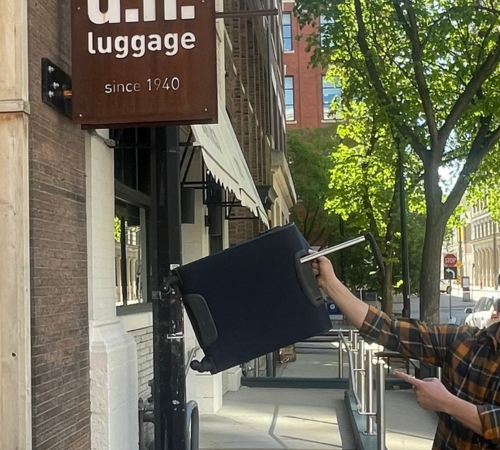
The Traveller’s Guide to Buying the Best Luggage: Avoid These Common Blunders!
When buying luggage or a suitcase, many travellers make several common mistakes that can lead to inconvenience, additional costs, and dissatisfaction with their purchase. Let's dive into the five most common mistakes and how to avoid them when choosing the best luggage for your travels.
1. Choosing the Wrong Size:
Oversized Suitcase: Picture this: you’re in the store, eyeing the largest suitcase available, thinking you’ll never run out of space! But fast forward to the airport, and you’re struggling with a behemoth that makes you look like you’re moving house. Airlines like Air Canada and WestJet have a 62-inch linear limit for checked bags (that's height + length + depth for the math-challenged among us). Anything bigger, and you're into “cargo” territory, incurring extra fees unless you’re shipping a herd of elephants.
Undersized Suitcase: On the flip side, there’s the tiny suitcase that looks adorable but barely fits your toothbrush. Imagine trying to stuff all your belongings into a bag that wouldn’t be out of place in a dollhouse. Many travellers get around this by purchasing a brand of suitcase that has an expansion system. The best of these would be offered by the Briggs & Riley Baseline collection, who’s expansion system is top notch and essentially offers two sizes of suitcase in one bag. If you must, carry a lightweight “comeback bag” for those just-in-case moments.
2. Ignoring Weight:
Heavy Suitcase: Ever lifted an empty suitcase and thought, “Did they line this with lead?” Some suitcases are so heavy they seem like they’re made from neutron stars. These heavyweights eat into your precious weight allowance faster than a sumo wrestler at an all-you-can-eat buffet. Lightweight suitcase options, like those from Samsonite, can save you from this plight, but beware: sometimes lightweight equals fragile. Think of it like the difference between a racehorse and a Clydesdale. Both useful, but in very different ways.
Overpacking: It’s tempting to pack everything including the kitchen sink. After all, what if you need that fifth pair of shoes? But overpacking leads to overweight baggage fees that’ll make your wallet cry. Air Canada and WestJet slap on extra charges for bags over 50lbs, so unless you’re planning on a cross-country powerlifting competition, keep it light.
3. Neglecting Durability and Material Quality:
Poor Quality Material: Buying a cheap suitcase is like investing in a chocolate teapot: looks good, but falls apart under pressure. Low-quality materials lead to tears, broken zippers, and wheels that snap off faster than you can say “baggage claim.”
Durability Underestimations: Frequent fliers, listen up! You need a suitcase that can take a beating and keep on rolling. Think polycarbonate vs. nylon luggage, ballistic nylon, or aluminum—materials tougher than a superhero’s costume. Brands that offer repair parts for wheels and handles are your best friends here. Imagine trying to drag a wheel-less suitcase through the airport; it's not a pretty picture.
4. Overlooking the Importance of Wheels and Handles:
Inadequate Wheels: Two-wheelers (or “rollers”) might remind you of your old skateboard, but four-wheelers (or “spinners”) glide smoother than an Olympic ice skater on airport floors. However, if your travels take you over cobblestones, snow, or anything that isn’t as smooth as a baby’s bottom, two wheels might actually serve you better. From the perspective of a repair shop, 4 wheels spinners need repair and replacement far more often than the older style 2 wheel rollers.
Weak Handles: Nothing ruins a trip faster than a handle that snaps off in your hand. Make sure your suitcase’s handle is sturdy, telescoping, and adjustable to different heights. A good handle is like a trusty sidekick; you don’t realize how much you need it until it’s gone.
5. Ignoring Organizational Features and Accessibility:
Lack of Compartments: A suitcase with no compartments is like a teenager’s bedroom—total chaos. Look for suitcases with multiple compartments, mesh pockets, and internal straps to keep everything in its place. Because who wants to dig through a jumbled mess to find their socks?
Accessibility Issues: Some suitcases are about as user-friendly as a Rubik’s cube. Features like front compartments for easy access to essentials can save you from the frustration of rummaging around for your boarding pass while the TSA agent gives you the stink eye.
Tips to Avoid These Mistakes:
Assess Your Needs: Think about your typical trip length and frequency. Choose a size that fits your travel style without being as cumbersome as a circus tent.
Check Airline Requirements: Avoid additional fees by knowing the size and weight restrictions of the airlines you use. No one likes surprise charges at the airport.
Research Materials: Invest in high-quality, durable materials that can withstand the rigors of travel. Your suitcase should be tougher than the journey it undertakes.
Test the Wheels and Handles: Ensure the wheels roll smoothly and the handles are comfortable and robust. It’s the difference between traveling in style and struggling like a pack mule.
Look for Organizational Features: Choose a suitcase with enough compartments and pockets to keep your items organized and easily accessible. A well-organized suitcase is the key to stress-free travel.
By paying attention to these factors, you can select a suitcase that will not only meet your needs but also last longer and make your travels infinitely more enjoyable. Happy packing, and may your travels be as smooth as your suitcase’s wheels!



I was having a hard time making a selection on a smaller 20 inch suitcase for travel until I read your article.
Thanks for helping me make a decision between Bugatti and Samsonite.
This is just the kind of information I was looking to find. Lots of points that I will keep in mind when searching for luggage. I don’t travel much so I needed the help in what to look for before I made a purchase. Thanks!
I enjoyed reading this. Whoever wrote this, well done! Made me chuckle and I learnt a lot.